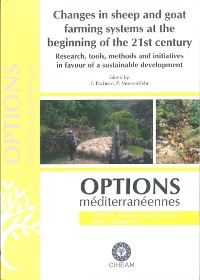| p. 13-20 | Article suivant |
Multi-criteria evaluation of small ruminant farming systems sustainability in Lebanon and Algeria
The sustainability of 129 small ruminant farming systems in Lebanon and 100 in Algeria was analysed on the basis of the quantitative multi-criteria method IDEA (Indicateurs de Durabilité des Exploitations Agricoles, or Farm Sustainability Indicators). Forty-one indicators covering the agro-ecological (including biodiversity, land management, agricultural practices), socio-territorial (product quality, employment and services, ethics and human development) and economical (viability, independency, transmissibility and efficiency) dimensions of sustainability were considered and applied in different contexts: sedentary, semi-transhumant, transhumant, semi-nomad or nomad production systems. Some indicators of the original method were inadequate in these systems, other were reformulated on the basis of appropriate references. In a semi-arid and pastoral context, the stocking rate, soil fertilisation, or nitrogen balance are examples for which more specific information is needed. The relative weighting of indicators deserves also attention. This methodological approach allowed identifying different categories of systems according to the three dimensions of sustainability. Global scores of sustainability were attributed to the more diversified systems such as the sedentary or horizontal transhumant ones. This method can be used to generate decision support tools and to model the sustainability of livestock farming system.
Le niveau de durabilité de 129 systèmes de production de petits ruminants au Liban et de 100 en Algérie a été analysé sur la base de la méthode multicritères IDEA (Indicateurs de Durabilité des Exploitations Agricoles). Quarante et un indicateurs couvrant les dimensions agro-écologique (biodiversité, organisation de l'espace, pratiques agricoles), socio-territoriale (qualité des produits, emploi et services, éthique et développement humain) et économique (viabilité, indépendance, transmissibilité, efficience) de la durabilité ont été mis en oeuvre dans différents types de systèmes de production : sédentaire, semi-transhumant, transhumant, semi-nomade ou nomade. Certains indicateurs de la méthode originale se sont avérés inopérants, d'autres ont été reformulés sur la base de références plus adaptées. Dans un contexte pastoral en milieu semi-aride, le chargement animal, la fertilisation des sols, ou le bilan azoté requièrent une approche spécifique. De plus, la pondération relative des indicateurs doit être réévaluée. L'approche méthodologique mise en oeuvre a permis de caractériser les systèmes selon les différentes dimensions de la durabilité ; les systèmes les plus diversifiés (sédentaires ou transhumants horizontaux) présentent les meilleurs scores globaux. Cette méthode peut servir de base au développement d'outils d'aide à la décision et à la modélisation de la durabilité des systèmes de production.
- [ Afficher ]
- [ Télécharger ]
- [ Exporter la citation ]
Vous pouvez télécharger la citation au format :
- [ Imprimer ]
-
Mots-clés
ALGERIE, CAPRIN, DURABILITE, INDICATEUR, LIBAN, METHODE STATISTIQUE, OVIN, SYSTEME D'EXPLOITATION AGRICOLECiter cet article
Marie M., Srour G., Ziki B., Abi Saab S., Yakhlef H., Ghozlane F. Multi-criteria evaluation of small ruminant farming systems sustainability in Lebanon and Algeria. In : Pacheco F. (ed.), Morand-Fehr P. (ed.). Changes in sheep and goat farming systems at the beginning of the 21st century : research, tools, methods and initiatives in favour of a sustainable development . Zaragoza : CIHEAM / DRAP-Norte / FAO, 2009. p. 13-20. (Options Méditerranéennes : Série A. Séminaires Méditerranéens; n. 91). Proceedings of the Seminar of the Subnetwork on Production Systems of the FAO-CIHEAM Network for Research and Development in Sheep and Goats, 2007/11/15-17, Ponte de Lima (Portugal). http://om.ciheam.org/om/pdf/a91/00801119.pdf



